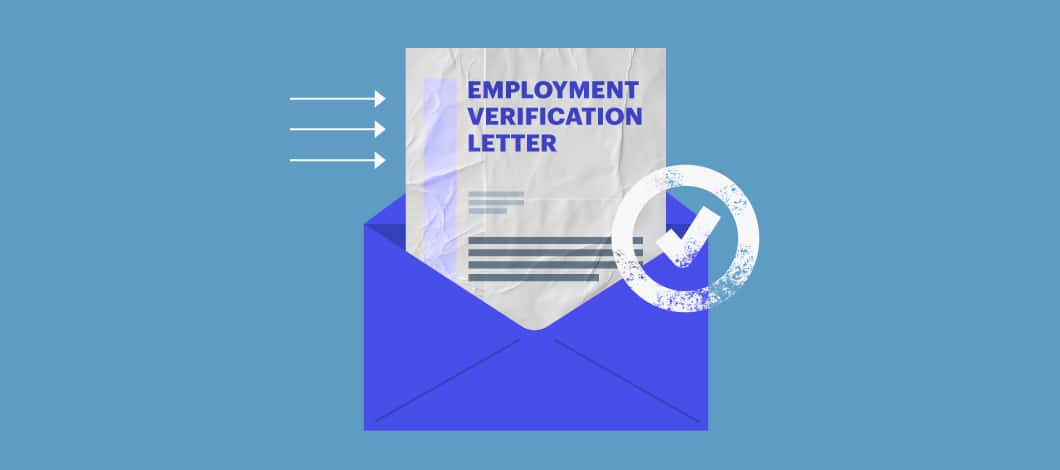Your current or former employees might request an employment verification letter for various reasons, including future employment or getting approval for a loan or mortgage.
Let’s go through how to write an employment verification letter and when you’d need to provide this document. We’ll also share employment verification letter samples and templates you can download and customize.
What Is an Employment Verification Letter?
An employment verification letter (EVL), proof of employment or verification of employment (VOE) letter, despite its title, is more than just a letter. It’s a legal document proving the dates and details of a current or previous employee’s relationship with your business. These letters can be required for a work permit and visa application, income verification by mortgage and loan companies (or debt collectors), background checks by landlords, potential employers and more.
Because employment verification letters are used to share personal details about an employee with a third party, the content is governed by both employment law and data protection regulations. This is why even if you want to write your own employment verification letter from scratch, it’s important to make sure you have a good idea of the rules and regulations that apply.
Applicable laws also vary depending on whom your employment verification letter is for, who requested it and whether the employee in question has given permission for the request. Additionally, laws about employee consent and what data can and must be released vary from state to state.
As an employer, you need more than just a couple of template letters to cover most eventualities. You need a clear, concise employment verification policy. What’s more, you must make sure anyone responsible for writing employment verification letters has enough training to prevent them from breaking any of the associated laws. Without these precautions, your company is at risk of prosecution.
-
Consent
Consent from the employee isn’t always a legal requirement, but some states have laws that make written consent mandatory. It’s safer to assume that consent is a must-have, as it provides legal protection in case of any problems down the line.
How to Write an Employment Verification Letter
Before you write your own employment verification letter, the first thing you need to do is read up on the laws that apply in your state. If your workplace already has a policy, you can save time by using that as a reference.
Employment Verification Letter Elements
1. Follow the business letter format: Align your text on the left and include the following elements in this order:
- Your business’s address
- The date
- Recipient’s address
- Salutation
- Body
- Closing
- Signature
- Note any enclosures or attachments
2. Include the following, at a minimum:
- Name, date of birth and social security number of the employee in question
- The employee’s job title plus the name and address of the company
- The start date of their employment and the termination date (if no longer employed there)
- The employee’s salary details, including the average hours worked per week
A more detailed letter for a prospective employer could contain:
- Information about the individual’s job functions
- Notes about the person’s attitude at work
- Reasons for termination of employment and whether or not that person is eligible for rehire
3. Keep it simple: A general rule of thumb is to only provide the information necessary for the letter’s purpose — i.e., if the letter is for a rental agent, you don’t need to include in-depth info on the worker’s job responsibilities.
4. Add contact details: Keep any statement of employment letter brief, but you can include your contact information and invite the letter’s recipient to call you with questions or for clarification.
If you receive an unsolicited request for an EVL from a debt collector or other third party, you’re not obligated to share any details about your worker.

Why Do You Need an Employment Verification Letter?
Your confirmation of employment letter’s content depends heavily on its purpose, so here are some common reasons for needing an EVL.
Rent or Lease Agreements
A common reason for an EVL is as part of a background check before a rent or lease agreement. You’ll usually get employment verification requests regarding current employees to confirm whether or not the employee has a steady income to afford the rent and deposit.
Always seek written permission from the worker before giving out these details.
Immigration
Many types of visa applications require an individual to provide proof of employment. H1B visa applications and green card applications are some of the more common reasons for immigration-related requests. There will be a letter of advice from the government department detailing what must be included in the letter.
Home and Auto Loans
If an employee is applying for a mortgage or car loan, they’ll likely reach out to you for an employment income verification letter. Traditional and online lenders want to ensure an existing employee is financially secure enough to afford a loan.
Government Agencies
Sometimes a current employee might face wage garnishment from a government agency, and you’ll be asked to submit an employment verification letter. Like other government letters, you should be provided with guidance on what to include in an employment verification letter. As a general rule, include hours worked per week and current/final salary, along with the reason for termination if you’re talking about a former employee.
Potential Employers
If a former employee (or perhaps a current employee) is interviewing for a new job, someone from the hiring company will reach out to you to confirm details about the employee’s time at your business. In addition to basic information about job title, employer and salary, these requests should also include the individual’s reason for leaving, a more detailed overview of the job role and whether or not the person is eligible for rehire. How much more detail you go into is up to you. No federal laws govern how much or little you can say about your employee, but state laws vary.
Typically, prospective employers will want to know about job performance, specific responsibilities and attitude at work. You aren’t obliged to provide any information; it’s wise to keep it simple and to the point. Even when you provide negative feedback about the employee, stick to minimal facts.
How to Request an Employment Verification Letter
When you’re looking to hire a new employee, you might need to request an EVL from interviewees’ most recent employers. Take the following steps:
- Written consent is almost always needed before you make any calls or send any letters.
- Verify the company’s contact details by looking them up online or elsewhere.
- Call the company and speak with HR (regardless of who has been suggested as a contact).
- Say what the call is about, including the employee’s name and, if necessary, the employee’s date of birth and social security number to make sure you’ve got the right person.
- Ask for confirmation regarding whether the person works or has worked there, and find out the procedure for requesting an EVL.
Request for Confirmation of Employment Sample Letter
EMPLOYMENT VERIFICATION LETTER
Dear Sir/Madam,
I’m contacting you to request verification of employment for your former employee:
[Name, DoB, Social Security Number]
[Name] has applied for a job with [Your Company]. Please provide the following information:
- Name, date of birth, social security number
- Job title and responsibilities
- Reason for termination, and whether this person is eligible for re-employment
- Their final salary
- Anything else you can say about their performance at work
I have attached their written consent.
Many thanks,
[Your Name]
[Your Phone Number]
[Your Job Title]
Employment Verification Letter Samples and Templates
Here are sample text and templates to use in part or in whole for your own confirmation of employment letters.
Employment verification letter sample for an existing employee’s loan or rental agency application (or similar)
EMPLOYMENT VERIFICATION LETTER
Dear [Name],
Thank you for your request for an employment verification letter regarding:
[Employee Name, DoB, Social Security Number]
I can confirm that the following information is true:
NAME OF COMPANY:
JOB TITLE:
DATE OF EMPLOYMENT:
CURRENT SALARY:
Many thanks,
[Your Name]
[Your Phone Number]
[Your Job Title]
Download this employment verification letter template
Sample employment verification letter for a previous employee’s job application:
EMPLOYMENT VERIFICATION LETTER
Dear [Name], Thank you for your inquiry about:
[Name, DoB, Social Security Number]
I can confirm that [Name] is a previous employee of [Company Name], and that the following details are true:
NAME OF COMPANY:
JOB TITLE:
MOST RECENT SALARY:
DATE OF EMPLOYMENT:
DATE OF TERMINATION OF EMPLOYMENT:
REASON FOR LEAVING:
ELIGIBLE FOR RE-EMPLOYMENT: Y / N
ANY OTHER INFORMATION:
Many thanks,
[Your Name]
[Your Phone Number]
[Your Job Title]
Download this employment verification letter template
Certificate of Employment Sample
You might send a certificate of employment rather than an employment verification letter. However, the elements are similar to what you’d include in a letter, such as:
- Company letterhead or logo
- Your business name
- The employee’s name
- Job title
- Dates of employment and termination
- Salary
- Signature
You can view, download and customize the following file:









